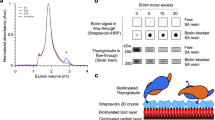Summary
Thyroglobulin-like immunoreactivity of the parafollicular cells was studied by an immunoperoxidase bridge technique using antisera against dog thyroglobulin fragments.
-
1.
The dog parafollicular cells were specifically stained by anti-peak I (27S and larger components fraction) antiserum absorbed with peak II (19S fraction). By this method, they were easily distinguishable from the non-reactive follicular cells and colloid droplets. More sensitive staining of the parafollicular cells was possible with anti-peak I (larger components fraction) antiserum. The staining reactions indicated that the antigenic material responsible for immunoreactivity of the parafollicular cells was due to larger molecular components of thyroglobulin corresponding to 32S, 37S or >37S, and was not due to either the 19S thyroglobulin or to the 27S iodoprotein.
-
2.
A conspicuous decrease of the immunoreactive material in the parafollicular cells occurred in the dog after both chronically induced hypercalcemia and antithyroid drug treatment. This coincided with movement of secretory granules containing calcitonin as shown by staining with silver impregnation, HCl-basic dye, and lead-hematoxylin.
-
3.
The antisera against larger molecular components of dog thyroglobulin showed a high degree of cross-reactivity to the parafollicular cells of most of the mammalian species investigated; rats, rabbits, hamsters, mice, cats, lions, goats, cows, and human.
Similar content being viewed by others
References
Berg, G., Björkman, U.: The structure and properties of 27s and larger iodoproteins in the thyroid gland. Biochim. biophys. Acta (Amst.) 405, 11–22 (1975)
Bilstad, J.M., Edelhoch, H., Lippoldt, R., Rall, J.E., Salvatore, G.: Isolation and characterization of discrete fragments of 27s thyroid iodoprotein. Arch. Biochem. Biophys. 151, 341–350 (1972)
Brewer, H.B., Jr.: Bovine thyrocalcitonin. In: Calcitonin 1969 proceedings of the second international symposium. London: Heinemann 1970
Gabe, P.M.: Données histochimiques sur les cellules parafolliculaires de la glande thyroïde du chien. Acta anat. (Basel) 38, 332–344 (1959)
Haddad, A., Pelletier, G., Marchi, F., Brasileiro, I.L.G.: Light microscope radioautographic study of glycoprotein secretion in the hypothalamic-neurohypophysial system of the rat, after L-fucose-3H injection. Cell Tiss. Res. 177, 67–79 (1977)
Hopkins, C.R.: Synthesis and secretion of a large glycoprotein in the pars intermedia. J. Endocr. 65, 225–231 (1975)
Kameda, Y.: Parafollicular cells of the thyroid as studied with Davenport's silver impregnation. Arch. histol. jap. 30, 83–94 (1968)
Kameda, Y.: Increased mitotic activity of the parafollicular cells of the dog thyroid in experimentally induced hypercalcemia. Arch. histol. jap. 32, 179–192 (1970)
Kameda, Y.: The occurrence of a special parafollicular cell complex in and beside the dog thyroid gland. Arch. histol. jap. 33, 115–132 (1971)
Kameda, Y.: Electron microscopic studies on the parafollicular cells and parafollicular cell complexes in the dog. Arch. histol. jap. 36, 89–105 (1973)
Kameda, Y.: Light and electron microscopic alterations of the dog parafollicular cells induced by antithyroid drug. Arch. histol. jap. 36, 205–220 (1974)
Kameda, Y.: Fine structural and endocrinological aspects of thyroid parafollicular cells. In: Chromaffin, enterochromaffin and related cells (R.E. Coupland and T. Fujita, eds.). Amsterdam: Elsevier 1976
Kameda, Y., Ikeda, A.: Occurrence of immunoreactive thyroglobulin in the parafollicular cells of dogs. Experientia (Basel) 33, 538–540 (1977)
Kameda, Y., Ikeda, A.: The identification of a specific fragment of dog thyroglobulin responsible for immunoreactivity to the parafollicular cells. Endocrinology, in press (1978)
Nakagami, K., Warshawsky, H., Leblond, C.P.: The elaboration of protein and carbohydrate by rat parathyroid cells as revealed by electron microscope radioautography. J. Cell Biol. 51, 596–610 (1971)
Pelletier, G.: Autoradiographic studies of synthesis and intracellular migration of glycoproteins in the rat anterior pituitary gland. J. Cell Biol. 62, 185–197 (1974)
Roch, J., Salvatore, G., Sena, L., Aloj, S., Covelli, I.: Thyroid iodoproteins in vertebrates: Ultracentrifugal pattern and iodination rate. Comp. Biochem. Physiol. 27, 67–82 (1968)
Salvatore, G., Vecchio, G., Salvatore, M., Cahnmann, H.J., Robbins, J.: 27s thyroid iodoprotein. J. biol. Chem. 240, 2935–2943 (1965)
Ui, N.: Neutral and amino sugar composition of thyroglobulin. J. Biochem. (Tokyo) 74, 593–599 (1973)
Van der Walt, B., Van Jaarsveld, P.: Bovine 37s iodoprotein: Isolation and characterization. Arch. Biochem. Biophys. 150, 786–791 (1972)
Author information
Authors and Affiliations
Additional information
This work was supported by a grant from the Ministry of Education of Japan
Rights and permissions
About this article
Cite this article
Kameda, Y., Ikeda, A. Immunohistochemical study of a large molecular fragment of thyroglobulin in parafollicular cells. Cell Tissue Res. 187, 429–438 (1978). https://doi.org/10.1007/BF00229607
Accepted:
Issue Date:
DOI: https://doi.org/10.1007/BF00229607




